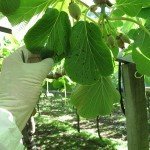Samples of kiwifruit pollen collected from the Bay of Plenty and South Auckland in 2009 and 2010 contain DNA from the bacteria that causes vine canker — Pseudomonas syringae pv actinidiae (Psa) — and researchers say there is now evidence that the disease incursion originated in China.
In recent years New Zealand imported only 2kg of kiwifruit pollen from China and 77kg of pollen from Chile, but Psa has also infected Chilean crops, and the scientists are now looking at whether the Chinese infection actually entered New Zealand via Chile.

Otago University biochemist Associate Professor Russell Poulter said today that the question of whether the New Zealand outbreak may have come via Chile will soon be
answered, by using DNA sequencing at the taxpayer-funded New Zealand Genomics Ltd operation.
“Having provided the tools, through sequencing, to recognise the different strains, we now want to determine the pathway by which the Psa came into the New Zealand,” Prof Poulter said in a statement.
“It’s unlikely to be on someone’s boots or via quarantined channels. And we know the particular strain did not originate from Europe. We need to know the pathway, so we can help other countries – and ourselves – avoid similar mistakes in future”.
After the vine canker was confirmed in New Zealand in November 2010, bacterial DNA was found in pollen collected from New Zealand vines in 2009 and 2010. This led to concerns among growers that some of the 300 tonnes of male flowers picked each year for their pollen to be used in fertilising crops might have been taken from infected vines.
Though about 80,000 beehives are brought into orchards during flowering to pollinate vines, had been increasing their use of artificial pollination in recent years,with an estimated 20 percent to 30 percent of the nation’s kiwifruit orchards supplementing the job done by bees. About 3 tonnes of pollen collected in New Zealand was sprayed or blown onto the vines, to aid pollination because the vines do not naturally attract bees.
Some growers were critical that the Government allowed pollen imports and that they were not consulted first, and said most growers did not realise some of the pollen they were buying might have come from overseas.
“It wasn’t known at the time amongst growers that anyone was importing pollen,” said Russell West, whose Te Puke orchard was the first to be found with Psa in November 2010.
“If people had known that, they would have re-thought the issue and the risks.”
Inititally, MAF said there was no evidence to show that Psa in pollen could infect healthy kiwifruit vines, but it later warned growers that pollen might be a carrier for the bacteria and suggested that if they had to use artificial pollination, pollen collected from their own property might present a lower risk.
Imports of kiwifruit pollen were not routinely tested at the border for the disease , and MAF pollen had been imported from China for laboratory testing purposes, and it was Chilean pollen which was applied to crops.
When Federated Farmers said there was a strong possibility the disease incursion had been through imported pollen and called for an immediate ban on pollen imports, Biosecurity Minister David Carter discounted those sorts of claims as premature.
At Otago University, Associate Prof Poulter, Professor Iain Lamont and Dr Margi Butler today said the New Zealand strain was significantly different from the strain in Italian crops, and that Italy could not have been the source.
“Through a process of elimination, Chinese pollen appears to be the likely source of New Zealand’s outbreak,” they said in a statement. “China is the original source of both the Italian and New Zealand outbreaks. More recently, Psa has been confirmed in Chile and work has begun on sequencing these strains. Preliminary data suggests that the Chilean strain also originates from China”.
The Illumina HiSeq sequencing service at NZGL – a collaborative infrastructure of genetic sequencing technology and expertise, involving Auckland, Massey and Otago universities — was used to determine the Psa genome after the country’s biggest kiwifruit handler, Seeka commissioned research with No2 industry player EastPack.
– Kent Atkinson